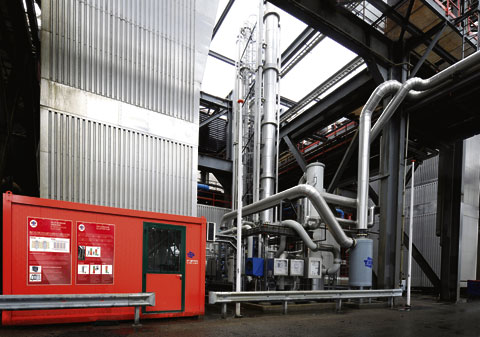Despite being energy-inefficient, bulky and expensive, CO2 capture from flue gases will have to be scaled up quickly. It’s the only way to make it affordable as well as necessary, says dr. Mohammad Abu Zahra, who defended his thesis last Tuesday.
Mohammad Abu Zahra vividly remembers the opening of the Eon power plant, a large-scale test facility located at the Maasvlakte. It was April 3rd of last year when a delegation featuring environment minister, Jacqueline Cramer, travelled by boat to the new power plant to officially open the CO2 capture research facility. Suddenly the delegation found itself surrounded by protesting Greenpeace activists in Zodiacs who were trying to prevent their boat from mooring. “They alleged we were helping Eon to keep using coal, while in fact we were only trying to make the use of coal greener”, Abu Zahra explains. The Maasvlakte facility is TNO’s newest and largest test facility. Previously, TNO had used a smaller set-up in Apeldoorn, which was later moved to Delft, for testing various solvents on a clean gas mixture. Not only is the new facility bigger, it also uses actual flue gas with dust particles and sulphur dioxide (SO2) from the coal-fired power plant for its tests. The installation needs six people for its operation when it filters less than a thousandth part of the total of flue gases from the 400-megawatt plant.
“Abu Zahra has screened both existing processes for CO2 capture, as well as new concepts”, says his PhD supervisor, prof.dr. Peter Jansens, a former professor of separation technologies at the faculty of Mechanical, Maritime and Materials Engineering. Jansens’ personal favourite is the part in which his PhD student wanted to use coal to absorb the last bit of CO2 from flue gases. “It’s like cleaning up your room. The first bit is relatively easy, but the last part demands most of the energy”, Jansens explains. He therefore welcomed Abu Zahra’s proposal to use the adsorption of coal itself to mop up the last traces of CO2 from the flue gases. Alas, it turned out that more coal was needed for gas cleaning than for firing the plant.
“There is no breakthrough technology”, Abu Zahra says. Nonetheless, he does believe that we need to start applying the technology as soon as possible. “There is a cost involved in emitting CO2 as well”, he says, referring to the hidden costs of climate change.
The process’ costs both in energy and euros are frankly deterring. Repeated heating and cooling of the solvent that captures CO2 from the flue gases requires a substantial part of the heat generated by the power plant. A full-sized capture facility will lower a plant’s efficiency by 8-11 percentage points, while the plant’s efficiency will typically fall from 47 to 37-39 percent. Or, as Jansens says, the Netherlands would need four additional power plants to make up for the energy loss in capture. Nevertheless, the process can be made more energy-efficient. Abu Zahra estimates that the energy demand can be lowered from 4 to 3,5 gigajoule per tonne of CO2. Apart from energy, CO2 capture costs a lot of money as well. Abu Zahra estimates current capture costs at 50-70 euro per tonne. Add another 10-15 euro for transport and storage and you’re looking at roughly 80 euro per tonne. “This is not a technology that will bring you benefits”, he dryly remarks.
Still there is hope in scales. Researchers often refer to the analogy of SO2 filtration of flue gases in the 1980s. Initially those costs were $100 per tonne, but the price has now come down to $20 or less.
In his new job at the IEA greenhouse gas R&D programme, Abu Zahra urges governments and industries to push the technology along to a full-sized demo by 2013. Money could come from carbon credits, CO2 taxes, revenues from enhanced oil and gas recovery or subsidies.
Where does he think this first ‘clean coal plant’ will be opened? China, he says. “Europe developed the technology but then got stuck in discussions. China might surge ahead, so that eventually we will need to buy the technology from them.”
PhD thesis: Mohammad Abu Zahra, ‘Carbon Dioxide Capture from Flue Gas’, October 13, 2009.
TU Delft’s student faculty council (SFC) has proposed the following to the TU’s Executive Board. SFC wants a campus bike repair, an ATM machine installed at the Sports & Culture Center, and a place for power-nap on campus. The bike repair shop would be run by high school students, the handicapped and TU students and offer less expensive service than Delft bike shops. The power-nap place would be a test project initially, offering a place where students and staff could take quick, 30-minute powernaps during the day.



Comments are closed.